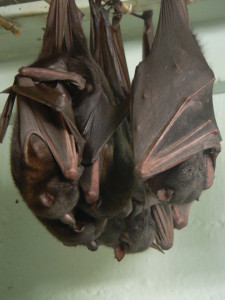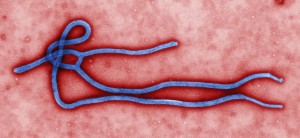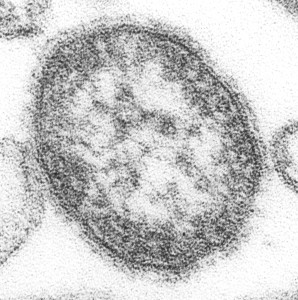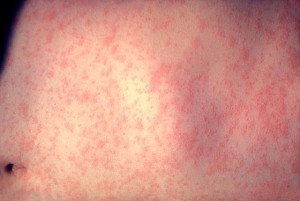Contagion is one of the few Hollywood films to employ on, the whole, highly credible science. As a movie "Contagion" more than hits home and, in my view, the most frightening aspect is the deliberate feel of the mundane and ordinary. It is skillfully brought to the forefront of the proceedings by its director Steven Soderbergh. Everything about the virus called MEV-1 is explained in a matter of fact and clinical manner, which for me makes it even more terrifying. Although the MEV-1 virus does not exist its creation resides with very real Nipah virus.
Defining and Organizing
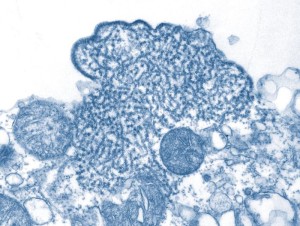
The Nipah virus, as with the fictional MEV-1 virus, is classified as a Biological Security Level (BSL) 4 microbe. This delimits the strictest level of pathogen containment and only few laboratories around the world, such as the Atlanta CDC, have the equipment and/or staff to deal with them. The MEV-1 virus is also a zoonotic lifeform; a disease causing (pathogenic) microbe which can be passed on to human beings. For example the family of rhabdoviruses which cause rabies is transmitted by via the saliva of carnivores such as skunks, foxes and coyotes. Swine flu or H1N1 influenza is highly contagious to pigs and can be transmitted to humans who come into contact with infected animals. The above levels of containment range from the lowest Biological Safety Level 1 (BSL-1) to the highest at Level 4 (BSL-4). These classifications do not include weaponisedweaponized versions which are significantly more dangerous than even the most lethal Level Four agents. The point is raised when the US Department of Homeland Security asks a cast member whether bird flu could be weaponisedweaponized. I think the response “the birds are already doing that,” underpins the scientific illiteracy and disconnect of the question.
Stimulus for Catastrophe
In 1999, flying foxes (bats of the genus pteropus) were established as the reservoir of the nipah virus. This family of microbes, known as Paramyxoviridae, have a single strand of RNA ensconced within a capsid structure or protein shell. This shell is made up of many sub units called capsomeres, each of which contains hundreds or thousands of protein molecules (it depends on the virus). The capsid serves to protect the virus from enzymes and other biological molecules in both reservoir and host organisms. There are also specialist molecules on the surface, such as glycol proteins. Such chemicals allow the virus particle to lock on and attach itself to the specific cells in the host organism. The capsid also possesses additional biological molecules which facilitate viral penetration to the hosts target cells thus causing disease. The Paramyxoviridae microbes are spread primarily by airborne droplets or via the body fluids of infected persons and surfaces they come into contact with. They cause a whole host of respiratory diseases in human beings such as Mumps, German measles (rubella), Parainfluenza (of which the 1919 global pandemic is one example), Newcastle disease, and Respiratory syncytial virus (RSV).
All of these viruses have an incubation period measured in days and, in the real world, some viruses can take weeks to fully incubate. Whether or not a person is contagious during the incubation period depends on the virus. For instance, Ebola can take up to 3 weeks to attack the human body and an infected person is not contagious until they start displaying symptoms. Here in resides the main area of cinematic and artistic licencelicense employed by the makers of “Contagion.” The MEV-1 virus has an incubation period of several hours whilst the nipah virus incubates between 4 and 18 days. In the real world the common cold and influenza have incubations of between and 1 and 3 days. To express it differently, there is no known pathogen that incubates as quickly as the fictional MEV-1 virus. Still, this is not the point of the “Contagion” story and this fact did not preclude Stephen King penning the genuinely apocalyptic arrival of Captain Trips, (one very minor plot spoiler) way back in 1978.
Exposition and realism
The script contains some wonderful scientific terminology. One key phrase is, “There is nothing obviously morphologically pathognomonic” about the agent. In other words the scientists have not worked out how the virus causes disease. Two minutes previously the MEV-1 virus it is described as “pleomorphic” and ovoid in shape with Glycoproteins on the outer surface, (being pedantic the term capsid should have been used). Glycoproteins are defined as any protein molecule which has a carbohydrate (such as glucose) attached to it. The term pleomorphic refers to any microbe which can change into different forms and display fungal, bacterial as well as viral characteristics. Pleomorphism increases a virus’ ability to evade the host immune system, the number of reservoir organisms and the mechanisms of transmisiontransmission. In “Contagion” MEV-1 infects brain and lung cells as they have the appropriate receptors for the glycoproteins on the capsid surface. This “key and lock mechanism” is a perfect way to explain how the immune system and other proteins such as enzymes function in an organism; the phrase is as perfect for the classroom as it was for the audience watching.

Another favouritefavorite clinical description explains that “the virus is Chimeric in origin”. The chimera was a terrible monster of Greek Mythology. Sent to Earth by the Gods, the creature wandered what is now Anatolia, the Mediterranean region of Turkey, causing mayhem and destruction everywhere it went. This fire breathing creature with the head of a male lion, the udders of a goat, the tail of a snake and a goat’s head and neck protruding from its back was slain by the hero Bellerophon.
Analogous with its Greek namesake a chimeric virus contains the genetic material of at least two different organisms. In the case of MEV-1 the danger is derived from the fusion pig and bat nucleic acid sequences. The following quote from “Contagion” impacts the point succinctly “somewhere in the world the wrong pig met up with the wrong bat”. Overall, the scientific exposition on the part of protagonists is suitably detached and in its entirety “Contagion” makes for a genuinely compelling and totally absorbing, “what if?” scenario.
Communication theory
As I watched the story unfold it became obvious that the film makers were not satisfied with just getting “the science right” but also wanted to ensure it was communicated effectively. Concurrently, as a science teacher I would not hesitate to recommend it for any AS/A level science (Grade 12 plus) students. For instance, the communication of the basic reproduction or R0 number was faultless in its simplicity. The R0 number tells us how infectious a virus is, put simply a virus spreads by infecting new hosts where it replicates itself, spreading disease as it does so. The R0 number tells us the theoretical average number of people who will become infected with the virus. The number depends on a number of variables, such as, the estimated time that patient zero came into contact with the agent, the length of time a person is infectious, the probability that an infected person will spread the disease to a non-infected person, how much contact infected persons have with non-infected persons, how many non-infected people an infected person is likely to come into contact with in a given time scale, and at what point is the person infectious as the agent progresses through its life cycle.
Clearly, we cannot answer these questions until we know what the infectious agent is and where it came from. Furthermore, the R0 number varies for any given disease in different populations, as indicated in the table below. It is crucial to impart that even in the most severe circumstances not every individual will succumb to a disease causing pathogen. In short some individuals will have a natural immunity or will recover and develop the same level of protection. Mathematically, this reality is expressed in a variable known as the effective reproductive rate of the virus. In essence the R number considers the mathematical expression of the likely number of secondary cases in a real population, based on the variables which determine the biological reproductive number. For instance, if we know that 75% of a population is immune to measles we can deduce that the R0 number (based on the information below) will be a maximum of 4.5.
| Disease | R0 Number | Mode of Transmission |
| Measles | 12--18 | Airborne |
| SARS | 2--5 | Aerosol |
| Ebola (2014) | 1.5--2.53 | Bodily Fluids |
| Diptheria | 6--7 | Saliva |
| Polio | 5--7 | Faeces/Water/Oral |
| Small Pox | 5--7 | Aerosol |
| Rubella | 5--7 | Aerosol |
| Mumps | 5--7 | Aerosol |
| HIV | 2--5 | Sex/Bodily Fluids |
| Influenza (1918) | 2--3 | Aerosol |
Furthermore it is crucial to stress that an epidemic can only occur if the R0 number is greater than 1. If it is less than one, the disease is not likely to spread. Taken collectively such epidemic theory numbers allow us to determine the degree of effort needed to prevent an outbreak or eliminate the pathogen from the susceptible population; the higher the number the more effort is needed. In my view there is an obvious caveat, the more likely the pathogen is to kill (as opposed to spread) the more effort should be brought to bear on saving lives and preventing the micro-organism from taking hold in the population. Ebola, with an R0 between 1.5 and 2.53, is (in theory), much easier to deal with and contain than measles with an R0 between 12 and 18. This being the case, it is important to remember that vaccines exist to deal with pathogens (such as measles), that were once recognized killers. The same is not true (at time of writing) for the ebola virus or the entire family of filo-viruses to which it belongs.
Assessing the risks
The 2014 outbreak of the haemorrhagic fever caused by the Ebola virus is by far the worst on record, eclipsing the previous incidence by a factor of four. According to figures from the CDC the 2014 outbreak infected approximately 23,000 people, with 10,000 confirmed deaths. This particular outbreak is infecting people with Ebola Zaire, which is the most lethal of the five strains of the virus, having a fatality rate of up to 90%. The simple fact is the every time a microbe comes into contact with other organisms it has the potential to mutate and evolve into a more communicable form. The bottom line is the Ebola is only transferrable by direct contact with the body fluids of an infected person once they have started to develop the horrific symptoms associated with the virus. In other words unlike MEV-1 and measles it is not an airborne micro-organism. At time of writing ebola shows no sign of evolving the capability to travel by air. Therefore, is possible to isolate and quarantine infected individuals once they start to develop symptoms. Herein lies the ethical and moral and dimension of the Ebola outbreak.
The woeful lack of resourcing for such preventative measures was a principal reason why so many people were killed in West Africa. In my view it is irresponsible to the point of criminality that this state of affairs is allowed to continue. Speaking personally I doubt it the 2014 will be the last or worst of its kind as I do not believe that mandarins of global power are interested in allocating the necessary resources. The background is stark; global military spending now sits at around 1.7 trillion dollars with about 50 billion spent in Africa alone every year. This figure does not include the sums spent on prosecuting the so called drone war in this part of the world. Such figures are encapsulated best in the phrase “killing versus helping” and on a global scale represent the direct opposite of “prevention being better than cure” strategy. In addition these skewed priorities are occurring against a background profound and sustained urbanization and environmental destruction which are overall creating the conditions which ensure that further outbreaks of diseases such as those caused by Ebola are as inevitable as they are severe. Overall, Ebola has had immediate devastating impacts across West Africa and the longer term economic and environmental effects are still being evaluated. My overall criticism is that the world was complacent and only took it upon itself when it appeared that the outbreak may spread outside of Africa.
Having said all of this, there was never any real possibility, (no matter how frightening) that this outbreak would have resulted in a global pandemic. Furthermore, one reason why there was a delayed response from the outside world was that the initial symptoms were similar to more familiar diseases such as Lassa fever and malaria. At time of writing samples taken from previous outbreaks of these diseases are being tested for strains of ebola Zaire and the four other known strains of the virus. As a corollary, and viewed through the context of the current measles outbreak (as of January 2015) in the US and confirmed cases in Europe, we underestimated the power of pathogenic microbes at our peril. Ebola virus has an R0 number of two because it takes up two three weeks for it to incubate and at presents exists in a form which is relatively hard to transmit. Furthermore, the virus is attuned to rapid replication in a human host rather than more rapid and lethal airborne transmission. A biological agent such as measles is orders of magnitude more contagious than ebola. However, do not be complacent ebola is formidable virus, if not contained it will spread and it will kill. The same is not necessarily true of measles.
Applying the numbers
The Morbillivirus which causes “The Measles”[/caption]The above table above suggests that measles has an R0 number which makes it at least six times more transmissible than Ebola. The MEV-1 virus attains at its worst an R0 number of four, making it three times less communicable than Morbillivirus which is the measles (rubella) disease causing agent. In other words measles will infect a minimum of 12 new susceptible persons for every new infection in a population. The reason for this is due to its primary mode of transmission. Morbillivirus is an airborne lifeform and (as far as human beings are concerned) is one of the most infectious microbes on the planet; it spreads by coughing, sneezing and inhalation of particles. Concurrently, the measles microbe can survive for several hours on a suitable surface, meaning that effective hygiene practices become even more important, should a measles outbreak occur. In short aside from actually getting the disease the only way to ensure immunity to measles is vaccination. It is important to state that prior to vaccination, contracting measles was all but inevitable and as such in unvaccinated populations the disease is still a common child killer. If an outbreak occurs in a population where not enough people are vaccinated, the only way to control the outbreak is quarantine. I am not suggesting that vaccination is without risk. However, it is not the subject of this article to discuss the very real benefits of vaccination as measured against the risks of secondary or future complications.
The measles virus will incubate for about four days and an infected person can transmit the morbillivirus microbe up to the appearance of the rash which gives the disease its name. In other words the potential for an R0 number of 18 is absolutely fully justified as an infected person can be passing the microorganism to all and sundry without exhibiting symptoms themselves. Furthermore, the infected person is still contagious until the rash starts to disappear. At this stage a person will be immune to that particular strain of the virus. Contrast with Ebola which is most communicable when the symptoms are progressing in their full and horrific frenzy and herein lays the proverbial rub. The US is now experiencing the worst measles outbreak since the turn of the 21st century, when the entire country was declared measles free. As we have established it is a highly communicable disease but is not normally lethal in itself to the majority of a population. However, in an un-vaccinated population the child fatality rate can reach 15% and even up to 30% should secondary complications such as pneumonia occur. The figures for the majority of the world’s population are significantly worse, principally due to the killing versus helping factors outlined previously. Ebola is fatal in up to 90% of cases but if effective protocols exist to prevent its spread an outbreak can be contained.
Concluding points
Albeit with radically different symptoms Contagion presents a terrifying sequence of events. Imagine an infectious agent as lethal as ebola, that is as transmissible as measles and has incubation period of only a few hours. In our globalised and interconnected world, if a virus such as MEV-1 ever came into existence and actually took hold then severe consequences would be almost inevitable. At the very least we would need to find an antidote in good time and even then nothing is guaranteed. The Black Death is perhaps the most infamous example of a global pandemic, but it is my no means an isolated example. Make no mistake about it a recurrent eventually on an equivalent scale would change the course of history.
For a movie such as Contagion, the filmmaking resides firmly in the domain of the realistic and empirical. At no point is the viewer allowed to forget that we are living the 21st century. The events portrayed take place in the very real world of disease, prevention, control and transmission. Therefore, the degree to which such comparisons can be made is only limited by events which have occurred (or have yet to), in the real world that we all inhabit. I therefore answer the titular question with an emphatic yes.


